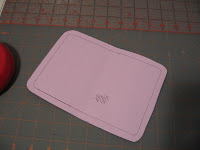
I really caught the tutorial bug from Sew, Mama, Sew! This is a tutorial about how to use a dryer sheet to make appliqué easy, quick, and non-scary. You could also use lightweight interfacing if your family doesn't use dryer sheets or if you are sort of a worrywart about your quilting . Your dryer sheet should be USED, and completely free of its fabric softener and chemicals. Tossing it in a load of wash after it's been used in the dryer should do the trick. Don't iron the dryer sheet, it will melt (ask me how I know). Throughout this tutorial, click the pictures to see them larger with glorious detail.
So, to start, gather a piece of scrap paper, a marker, scissors and the dryer sheet.

Draw your design on the paper, at the size you want your finished appliqué to be. Exception: long skinny things (like the beak, as seen below) should be drawn slightly longer and fatter than you intend them to end up.

Now lay the fabric sheet over the drawing. Trace the drawing onto the dryer sheet with the marker. This is the magic of the dryer sheet. It's kind of like fabric and kind of like tracing paper!

Find a piece of fabric big enough to accommodate your design plus 1/4" around. Lay the fabric right side up then put the dryer sheet over it, right side up. I know it seems wrong. Trust me.

Stitch along the pattern line, around the entire design. I prefer to do this step by machine but you can hand stitch just as well if you take small stitches.

Cut the piece out 1/4" from the stitching.

Clip the fabric away from any points. Snip the fabric along any concave curves (On the bird I clipped the crotch, the back of the neck, and under the beak). Skipping this step will cause heartache and gnashing of teeth! Do it!


Now use a sharp scissors to cut a slice just in the dryer sheet and not the fabric. Turn the piece right side out through this hole. No worries if you rip the slice farther, just try to keep the dryer sheet intact where it meets the fabric. The dryer sheet is going to end up sandwiched between your appliqué and your backing, so don't give it much mind.

See how all the raw edges are behind the fabric sheet? Now they can't shred when you're appliquéing!

Iron the appliqué from the fabric side to make it nice and flat. See how nicely it matches the original drawing!

Now you are ready to attach the appliqué to whatever backing you wish. If you already know how to appliqué, I hope you enjoyed the dryer sheet trick! If you don't know how to appliqué, read on... Put your appliqué where you want it and pin it down.

Thread a sharp needle. Knot the end of the thread. Bring the needle up from the wrong side of the backing, directly next to the appliqué. Reminder : enlarge these pictures by clicking on them if you need more detail.

Now put the point of the needle inside the folded edge of the appliqué, right next to where the thread is coming up from the backing.

Bring the needle back out of the folded edge of the appliqué, making a stitch about 1/4". Pull your thread through.

Now you are going to take a stitch below the backing WITHOUT turning your work over. Put the needle in the backing directly beneath where the thread is coming out of the appliqué.

Bring the needle back up, directly next to the appliqué, making a stitch about 1/4". Pull the needle through.

These are the only two stitches involved in appliqué. A stitch inside the folded edge of the appliqué...

Alternated with a stitch behind the backing... Whenever the thread comes up out of one fabric, it dives directly into the other fabric, so you end up seeing very little of the thread. It is always either traveling behind the folded edge of the appliqué or traveling beneath the backing.

Eventually you will realize that you can take a stitch in the applique, then go right into the stitch behind the backing, without pulling the thread through between stitches.

I like to make sure there is always a stitch right at any corner, to keep the appliqué well secured.

When you get back to where you started, take the needle beneath the backing, turn your work over and tie your thread off. You should see a dashed line of stitches in the outline of your applique.

And you're done. Hope that helped... Now, how about this rocking bird skirt!





















